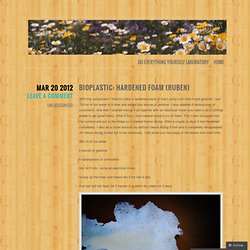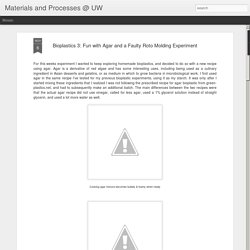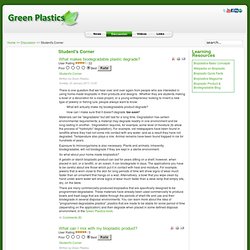

DIYchemistry. DIYchemistry. BIO-PLASTIC HANKBOOK 2011. BIOPLASTIC: HARDENED FOAM (Ruben) With this experiment I tried to make a hardened piece of foam using corn starch and gelatine.

I put 700 ml of hot water in a bowl and added four leaves of gelatine. I also addead 4 tablespoons of cornstarch. And then I started mixing it all together with an electrical mixer (you need a lot of stirring power to get good foam). After 5 min. I had created about 5 cm of foam. 700 ml of hot water 4 leaves of gelatine 4 tablespoons of cornstarch Mix for 5 min. using an electrical mixer.
Scoop up the foam and freeze dry it for half a day And last but not least let it harden in a warm dry place for 2 days. Moulages. Principes de base des moulages.

Je ne suis pas spécialiste en moulages, j'ai seulement acquis une expérience limitée dans ce domaine en fonction de mes lectures et de mes propres applications. Ce sont ces connaissances que je vous propose. A- Réalisation des moules : Que mouler et avec quoi ? Tout peut être reproduit par moulage : une pièce rigide, souple, de forme simple ou complexe, de petite ou grande taille. On peut même mouler un corps humain (et pour la petite histoire certains offrent à leur moitié un moulage d'une partie précise de leur anatomie ... en souvenir des temps glorieux ou pour usage personnel lorsqu'ils sont absents ?). Il existe une grande variété de produit destinés à prendre l'empreinte de l'objet à mouler : plâtre, latex, silicone, alginate, ...
Le choix sera guidé par le type d'objet à reproduire, mais aussi par les caractéristiques de la matière pour la prise d'empreinte. La silicone, appliquée sous forme liquide ou pâteuse, offre beaucoup d'avantages. Plastics. The monthly blog for Plastics Engineering magazine. By Jan H.

Schut When Coca Cola Co. (www.coca-cola.com) launched its “PlantBottle” in North America at the winter Olympics in Vancouver in 2010, plastics processors were skeptical. Coke’s Dasani water bottles claimed to be made of “up to 30% bio-based PET.” But when processors asked resin suppliers for bio content PET, it wasn’t available. Skeptics also noted that the bottles didn’t say “30% bio content” or “at least 30% bio content,” normal wording for post consumer recycled content. In fact, Coke had put an elaborate multi-national bio monomer supply chain in place, capable of meeting rapidly escalating demand for bio-content PET. To reach 30% bio content requires bio MEG, for which Coke bought bio ethanol in Brazil, shipped the bio ethanol to India, and had it made into bio MEG, which was then made into 30% bio content PET. Coke put a complex international supply chain in place to make 30% bio PET bottles.
By late 2010 Coke said it had distributed 2.5 billion “PlantBottles.” Green Plastics: the new science of bioplastic. Fun with Agar and a Faulty Roto Molding Experiment. For this weeks experiment I wanted to keep exploring homemade bioplastics, and decided to do so with a new recipe using agar.

Agar is a derivative of red algae and has some interesting uses, including being used as a culinary ingredient in Asian desserts and gelatins, or as medium in which to grow bacteria in microbiological work. I first used agar in the same recipe I've tested for my previous bioplastic experiments, using it as my starch. It was only after I started mixing these ingredients that I realized I was not following the prescribed recipe for agar bioplastic from green-plastics.net, and had to subsequently make an additional batch. The main differences between the two recipes were that the actual agar recipe did not use vinegar, called for less agar, used a 1% glycerol solution instead of straight glycerin, and used a lot more water as well. The results were pretty interesting. Foil and foam core geometric mold Foil and foam core geometric mold. Student's Corner. Download PDF (The characters Achilles and the Tortoise are taken from Douglas Hofstadter's Goedel, Escher, Back: an Eternal Golden Braid.)

Achilles (a Greek warrior, fleetest of foot of all mortals) comes across a Tortoise in a forest. The Tortoise is smashing a plastic box with a hammer. Achilles: Good afternoon, Tortoise. What on earth are you doing? Tortoise: I am finished with this plastic packaging, so I am returning it to the earth. Achilles: But all you are doing is hitting it with a hammer. Tortoise: Actually, if you must know, I am degrading it. Achilles: Degrading it?
Tortoise: No, no. These. Lapointe_R__06-09-2012_ GED00000416.